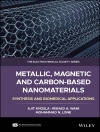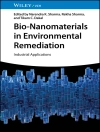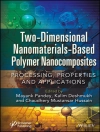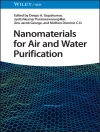Combining different perspectives from materials science, engineering, and computer science, this reference provides a unified view of the various aspects necessary for the successful realization of intelligent systems.
The editors and authors are from academia and research institutions with close ties to industry, and are thus able to offer first-hand information here. They adopt a unique, three-tiered approach such that readers can gain basic, intermediate, and advanced topical knowledge. The technology section of the book is divided into chapters covering the basics of sensor integration in materials, the challenges associated with this approach, data processing, evaluation, and validation, as well as methods for achieving an autonomous energy supply. The applications part then goes on to showcase typical scenarios where material-integrated intelligent systems are already in use, such as for structural health monitoring and smart textiles.
Innehållsförteckning
Foreword XV
Preface XIX
Part One Introduction 1
1 On Concepts and Challenges of Realizing Material-Integrated Intelligent Systems 3
Stefan Bosse and Dirk Lehmhus
1.1 Introduction 3
1.2 System Development Methodologies and Tools (Part Two) 7
1.3 Sensor Technologies and Material Integration (Part Three and Four) 8
1.4 Signal and Data Processing (Part Five) 15
1.5 Networking and Communication (Part Six) 17
1.6 Energy Supply and Management (Part Seven) 21
1.7 Applications (Part Eight) 21
References 24
Part Two System Development 29
2 Design Methodology for Intelligent Technical Systems 31
Mareen Vaßholz, Roman Dumitrescu, and Jürgen Gausemeier
2.1 From Mechatronics to Intelligent Technical Systems 32
2.2 Self-Optimizing Systems 36
2.3 Design Methodology for Intelligent Technical Systems 38
2.3.1 Domain-Spanning Conceptual Design 41
2.3.2 Domain-Specific Conceptual Design 50
References 51
3 Smart Systems Design Methodologies and Tools 55
Nicola Bombieri, Franco Fummi, Giuliana Gangemi, Michelangelo Grosso,
Enrico Macii, Massimo Poncino, and Salvatore Rinaudo
3.1 Introduction 55
3.2 Smart Electronic Systems and Their Design Challenges 56
3.3 The Smart Systems Codesign before SMAC 57
3.4 The SMAC Platform 60
3.4.1 The Platform Overview 61
3.4.1.1 System C–System Vue Cosimulation 61
3.4.1.2 ADS and the Thermal Simulation 63
3.4.1.3 EMPro Extension and ADS Integration 64
3.4.1.4 Automated EM – Circuit Cosimulation in ADS 64
3.4.1.5 HIF Suite Toolsuite 65
3.4.1.6 The MEMS+ Platform 66
3.4.2 The (Co)Simulation Levels and the Design–Domains Matrix 67
3.5 Case Study: A Sensor Node for Drift-Free Limb Tracking 69
3.5.1 System Architecture 71
3.5.2 Model Development and System-Level Simulation 71
3.5.3 Results 73
3.6 Conclusions 76
Acknowledgments 77
References 77
Part Three Sensor Technologies 81
4 Microelectromechanical Systems (MEMS) 83
Li Yunjia
4.1 Introduction 83
4.1.1 What Is MEMS 83
4.1.2 Why MEMS 84
4.1.3 MEMS Sensors 84
4.1.4 Goal of This Chapter 85
4.2 Materials 85
4.2.1 Silicon 85
4.2.2 Dielectrics 86
4.2.3 Metals 87
4.3 Microfabrication Technologies 87
4.3.1 Silicon Wafers 87
4.3.2 Lithography 88
4.3.3 Etching 91
4.3.4 Deposition Techniques 93
4.3.5 Other Processes 94
4.3.6 Surface and Bulk Micromachining 95
4.4 MEMS Sensor 95
4.4.1 Resistive Sensors 95
4.4.2 Capacitive Sensors 99
4.5 Sensor Systems 103
References 104
5 Fiber-Optic Sensors 107
Yi Yang, Kevin Chen, and Nikhil Gupta
5.1 Introduction to Fiber-Optic Sensors 107
5.1.1 Sensing Principles 108
5.1.2 Types of Optical Fibers 108
5.2 Trends in Sensor Fabrication and Miniaturization 110
5.3 Fiber-Optic Sensors for Structural Health Monitoring 112
5.3.1 Sensors for Cure Monitoring of Composites 114
5.3.2 Embedded FOS in Composite Materials 114
5.3.3 Surface-Mounted FOS in Composite Materials 115
5.3.4 FOS for Structural Monitoring 115
5.3.4.1 Aerospace Structures 115
5.3.4.2 Civil Structures 116
5.3.4.3 Marine Structures 116
5.4 Frequency Modulation Sensors 117
5.4.1 Bragg Grating Sensors 117
5.4.2 Fabry–Pérot Interferometer Sensor 118
5.4.3 Whispering Gallery Mode Sensors 119
5.5 Intensity Modulation Sensors 122
5.5.1 Fiber Microbend Sensors 122
5.5.2 Fiber-Optic Loop Sensor 123
5.6 Some Challenges in SHM of Composite Materials 128
5.7 Summary 128
Acknowledgments 129
References 129
6 Electronics Development for Integration 137
Jan Vanfleteren
6.1 Introduction 137
6.1.1 Standard Flat Rigid Printed Circuits Boards and Components Assembly 137
6.1.2 Flexible Circuits 138
6.1.3 Need for Alternative Circuit and Packaging Materials 140
6.2 Chip Package Miniaturization Technologies 140
6.2.1 Ultrathin Chip Package Technology 140
6.2.2 UTCP Circuit Integration 142
6.2.2.1 UTCP Embedding 142
6.2.2.2 UTCP Stacking 143
6.2.3 Applications 143
6.3 Elastic Circuits 145
6.3.1 Printed Circuit Board-Based Elastic Circuits 145
6.3.2 Thin Film Metal-Based Elastic Circuits 148
6.3.3 Applications 148
6.3.3.1 Wearable Light Therapy 148
6.3.4 Stretchable Displays 149
6.4 2.5D Rigid Thermoplastic Circuits 152
6.5 Large Area Textile-Based Circuits 153
6.5.1 Electronic Module Integration Technology 154
6.5.2 Applications 155
6.6 Conclusions and Outlook 157
References 157
Part Four Material Integration Solutions 159
7 Sensor Integration in Fiber-Reinforced Polymers 161
Maryam Kahali Moghaddam, Mariugenia Salas, Michael Koerdt, Christian Brauner, Martina Hübner, Dirk Lehmhus, and Walter Lang
7.1 Introduction to Fiber-Reinforced Polymers 161
7.2 Applications of Integrated Systems in Composites 164
7.2.1 Production Process Monitoring and Quality Control of Composites 164
7.2.1.1 Monitoring of the Resin Flow 166
7.2.1.2 Analytical Modeling of Resin Front by Means of Simulation 166
7.2.1.3 Monitoring the Resin Curing 166
7.2.2 In-Service Applications of Integrated Systems 167
7.2.2.1 Use for Structural Health Monitoring (SHM) 167
7.2.2.2 Use As Support to Nondestructive Evaluation and Testing (NDE/NDT) 170
7.3 Fiber-Reinforced Polymer Production and Sensor Integration Processes 170
7.3.1 Overview of Fiber-Reinforced Polymer Production Processes 170
7.3.2 Sensor Integration in Fiber-Reinforced Polymers: Selected Case Studies 175
7.4 Electronics Integration and Data Processing 179
7.4.1 Materials Integration of Electronics 180
7.4.2 Electronics for Wireless Sensing 181
7.5 Examples of Sensors Integrated in Fiber-Reinforced Polymer Composites 183
7.5.1 Ultrasound Reflection Sensing 183
7.5.2 Pressure Sensors 184
7.5.3 Thermocouples 186
7.5.4 Fiber Optic Sensors 187
7.5.5 Interdigital Planar Capacitive Sensors 188
7.6 Conclusion 192
Acknowledgments 193
References 193
8 Integration in Sheet Metal Structures 201
Welf-Guntram Drossel, Roland Müller, Matthias Nestler, and Sebastian Hensel
8.1 Introduction 201
8.2 Integration Technology 204
8.3 Forming of Piezometal Compounds 205
8.4 Characterization of Functionality 208
8.5 Fields of Application 211
8.6 Conclusion and Outlook 212
References 212
9 Sensor and Electronics Integration in Additive Manufacturing 217
Dirk Lehmhus and Matthias Busse
9.1 Introduction to Additive Manufacturing 217
9.2 Overview of AM Processes 224
9.3 Links between Sensor Integration and Additive Manufacturing 228
9.4 AM Sensor Integration Case Studies 230
9.4.1 Cavity-Based Sensor and Electronic System Integration 236
9.4.2 Multiprocess Hybrid Manufacturing Systems 239
9.4.3 Toward a Single AM Platform for Structural Electronics Fabrication 243
9.5 Conclusion and Outlook 245
Abbreviations 246
References 248
Part Five Signal and Data Processing: The Sensor Node Level 257
10 Analog Sensor Signal Processing and Analog-to-Digital Conversion 259
John Horstmann, Marco Ramsbeck, and Stefan Bosse
10.1 Operational Amplifiers 260
10.2 Analog-to-Digital Converter Specifications 262
10.3 Data Converter Architectures 268
10.4 Low-Power ADC Designs and Power Classification 276
10.5 Moving Window ADC Approach 277
References 279
11 Digital Real-Time Data Processing with Embedded Systems 281
Stefan Bosse and Dirk Lehmhus
11.1 Levels of Information 281
11.2 Algorithms and Computational Models 283
11.3 Scientific Data Mining 287
11.4 Real-Time and Parallel Processing 291
References 297
12 The Known World: Model-Based Computing and Inverse Numeric 301
Armin Lechleiter and Stefan Bosse
12.1 Physical Models in Parameter Identification 302
12.2 Noisy Data Due to Sensor and Modeling Errors 304
12.3 Coping with Noisy Data: Tikhonov Regularization and Parameter Choice Rules 306
12.4 Tikhonov Regularization 308
12.5 Rules for the Choice of the Regularization Parameter 309
12.6 Explicit Minimizers for Linear Models 311
12.7 The Soft-Shrinkage Iteration 312
12.8 Iterative Regularization Schemes 313
12.9 Gradient Descent Schemes 314
12.10 Newton-Type Regularization Schemes 317
12.11 Numerical Examples in Load Reconstruction 318
References 326
13 The Unknown World: Model-Free Computing and Machine Learning 329
Stefan Bosse
13.1 Machine Learning – An Overview 329
13.2 Learning of Data Streams 331
13.3 Learning with Noise 333
13.4 Distributed Event-Based Learning 333
13.5 ε-Interval and Nearest-Neighborhood Decision Tree Learning 334
13.6 Machine Learning – A Sensorial Material Demonstrator 336
References 340
14 Robustness and Data Fusion 343
Stefan Bosse
14.1 Robust System Design on System Level 345
References 348
Part Six Networking and Communication: The Sensor Network Level 349
15 Communication Hardware 351
Tim Tiedemann
15.1 Communication Hardware in Their Applications 351
15.2 Requirements for Embedded Communication Hardware 352
15.3 Overview of Physical Communication Classes 354
15.4 Examples of Wired Communication Hardware 356
15.5 Examples of Wireless Communication Hardware 358
15.6 Examples of Optical Communication Hardware 360
15.7 Summary 360
References 361
16 Networks and Communication Protocols 363
Stefan Bosse
16.1 Network Topologies and Network of Networks 364
16.2 Redundancy in Networks 365
16.3 Protocols 366
16.4 Switched Networks versus Message Passing 368
16.5 Bus Systems 369
16.6 Message Passing and Message Formats 370
16.7 Routing 370
16.8 Failures, Robustness, and Reliability 377
16.9 Distributed Sensor Networks 378
16.10 Active Messaging and Agents 381
References 382
17 Distributed and Cloud Computing: The Big Machine 385
Stefan Bosse
17.1 Reference 386
18 The Mobile Agent and Multiagent Systems 387
Stefan Bosse
18.1 The Agent Computation and Interaction Model 389
18.2 Dynamic Activity-Transition Graphs 394
18.3 The Agent Behavior Class 395
18.4 Communication and Interaction of Agents 396
18.5 Agent Programming Models 397
18.6 Agent Processing Platforms and Technologies 404
18.7 Agent-Based Learning 415
18.8 Event and Distributed Agent-Based Learning of
Noisy Sensor Data 416
References 420
Part Seven Energy Supply 423
19 Energy Management and Distribution 425
Stefan Bosse
19.1 Design of Low-Power Smart Sensor Systems 426
19.2 A Toolbox for Energy Analysis and Simulation 430
19.3 Dynamic Power Management 434
19.3.1 CPU-Centric DPM 435
19.3.2 I/O-Centric DPM 437
19.3.3 EDS Algorithm 438
19.4 Energy-Aware Communication in Sensor Networks 440
19.5 Energy Distribution in Sensor Networks 442
19.5.1 Distributed Energy Management in Sensor Networks
Using Agents 443
References 446
20 Microenergy Storage 449
Robert Kun, Chi Chen, and Francesco Ciucci
20.1 Introduction 449
20.2 Energy Harvesting/Scavenging 451
20.3 Energy Storage 452
20.3.1 Capacitors 452
20.3.2 Batteries 458
20.3.3 Fuel Cells 467
20.3.3.1 Low-Temperature Fuel Cells 469
20.3.3.2 High-Temperature Fuel Cells 469
20.3.4 Other Storage Systems 469
20.4 Summary and Perspectives 470
References 470
21 Energy Harvesting 479
Rolanas Dauksevicius and Danick Briand
21.1 Introduction 479
21.2 Mechanical Energy Harvesters 480
21.2.1 Piezoelectric Micropower Generators 482
21.2.2 Micropower Generators Based on Electroactive Polymers 489
21.2.3 Electrostatic Micropower Generators 490
21.2.4 Electromagnetic Micropower Generators 491
21.2.5 Triboelectric Nanogenerators 492
21.2.6 Hybrid Micropower Generators 493
21.2.7 Wideband and Nonlinear Micropower Generators 494
21.2.8 Concluding Remarks 495
21.3 Thermal Energy Harvesters 496
21.3.1 Introduction to Thermoelectric Generators 496
21.3.2 Thermoelectric Materials and Efficiency 499
21.3.3 Other Thermal-to-Electrical Energy Conversion
Techniques 501
21.4 Radiation Harvesters 502
21.4.1 Light Energy Harvesters 502
21.4.2 RF Energy Harvesters 506
21.5 Summary and Perspectives 507
References 512
Part Eight Application Scenarios 529
22 Structural Health Monitoring (SHM) 531
Dirk Lehmhus and Matthias Busse
22.1 Introduction 531
22.2 Motivations for SHM System Implementation 536
22.3 SHM System Classification and Main Components 540
22.3.1 Sensor and Actuator Elements for SHM Systems 542
22.3.2 Communication in SHM Systems 550
22.3.3 SHM Data Evaluation Approaches and Principles 552
22.4 SHM Areas and Application and Case Studies 555
22.5 Implications of Material Integration for SHM Systems 561
22.6 Conclusion and Outlook 562
References 564
23 Achievements and Open Issues Toward Embedding Tactile Sensing and Interpretation into Electronic Skin Systems 571
Ali Ibrahim, Luigi Pinna, Lucia Seminara, and Maurizio Valle
23.1 Introduction 571
23.2 The Skin Mechanical Structure 573
23.2.1 Transducers and Materials 573
23.2.2 An Example of Skin Integration into an Existing Robotic Platform 575
23.3 Tactile Information Processing 579
23.4 Computational Requirements 582
23.4.1 Electrical Impedance Tomography 582
23.4.2 Tensorial Kernel 583
23.5 Conclusions 585
References 585
24 Intelligent Materials in Machine Tool Applications: A Review 595
Hans-Christian Möhring
24.1 Applications of Shape Memory Alloys (SMA) 596
24.2 Applications of Piezoelectric Ceramics 596
24.3 Applications of Magnetostrictive Materials 598
24.4 Applications of Electro- and Magnetorheological
Fluids 600
24.5 Intelligent Structures and Components 601
24.6 Summary and Conclusion 603
References 604
25 New Markets/Opportunities through Availability of Product Life Cycle Data 613
Thorsten Wuest, Karl Hribernik, and Klaus-Dieter Thoben
25.1 Product Life Cycle Management 613
25.1.1 Closed-Loop and Item-Level PLM 615
25.1.2 Data and Information in PLM 615
25.1.3 Supporting Concepts for Data and Information Integration in PLM 616
25.2 Case Studies 617
25.2.1 Case Study 1: Life Cycle of Leisure Boats 617
25.2.1.1 Sensors Used 618
25.2.1.2 Potential Application of Sensorial Materials 619
25.2.1.3 Limitations and Opportunities of Sensorial Materials 619
25.2.2 Case Study 2: PROMISE – Product Life Cycle Management and Information Using Smart Embedded Systems 620
25.2.2.1 Sensors Used 620
25.2.2.2 Potential Application of Sensorial Materials 621
25.2.2.3 Limitations and Opportunities of Sensorial Materials 621
25.2.3 Case Study 3: Composite Bridge 622
25.2.3.1 Sensors Used 623
25.2.3.2 Potential Application of Sensorial Materials 623
25.2.3.3 Limitations and Opportunities of Sensorial Materials 623
25.3 Potential of Sensorial Materials in PLM Application 623
Acknowledgment 624
References 624
26 Human–Computer Interaction with Novel and Advanced Materials 629
Tanja Döring, Robert Porzel, and Rainer Malaka
26.1 Introduction 629
26.2 New Forms of Human–Computer Interaction 630
26.3 Applications and Scenarios 633
26.3.1 Domestic and Personal Devices 633
26.3.1.1 The Marble Answering Machine 633
26.3.1.2 Living Wall: An Interactive Wallpaper 634
26.3.1.3 Sprout I/O and Shutters: Ambient Textile Information Displays 634
26.3.1.4 Flex Case: A Flexible Sensing and Display Cover 635
26.3.2 Learning, Collaboration, and Entertainment 635
26.3.2.1 Tangibles for Learning and Creativity 635
26.3.2.2 in FORM: Supporting Remote Collaboration through Shape Capture and Actuation 636
26.3.2.3 The Soap Bubble Interface 637
26.4 Opportunities and Challenges 637
26.5 Conclusions 639
References 639
Index 645
Om författaren
Stefan Bosse studied physics at the University of Bremen, Germany, from which he also received his Ph D. Since 2008 he is actively involved in different projects in the University of Bremen’s Scientific Center ISIS (Integrated Solutions in Sensorial Structure Engineering) pushing interdisciplinary research, and recently joined the ISIS council.
Dirk Lehmhus joined the Fraunhofer Institute for Manufacturing Technology and Advanced Materials (IFAM) in Bremen, Germany, in 1998 and subsequently obtained a Ph D in production technology from Bremen University for optimization studies of aluminium foam production processes and properties. Since May 2009 he is Managing Director at the University of Bremen’s Scientific Centre ISIS dedicated to the development of sensorial materials and sensor-equipped structures.
Walter Lang joined the Fraunhofer Institute for Solid State Technology (EMFT) in Munich, Germany, in 1987 where he worked on microsystems technology. In 1995, he became Head of the Sensors Department in the Institute of Micromachining and Information Technology of the Hahn Schickard Society. In 2003, he joined the University of Bremen where he is currently heading the Institute for Microsensors, -actuators and -systems at the Microsystems Center Bremen.
Matthias Busse holds the chair for near net-shape manufacturing technology in the Faculty of Production Engineering at the University of Bremen since 2003. At the same time, he became Director of the Fraunhofer IFAM. After his Ph D in mechanical engineering he worked in various positions at Volkswagen Central Research, ultimately as Head of Production Research. Matthias Busse represents the University of Bremen’s Scientific Centre ISIS as speaker of the board of directors.












